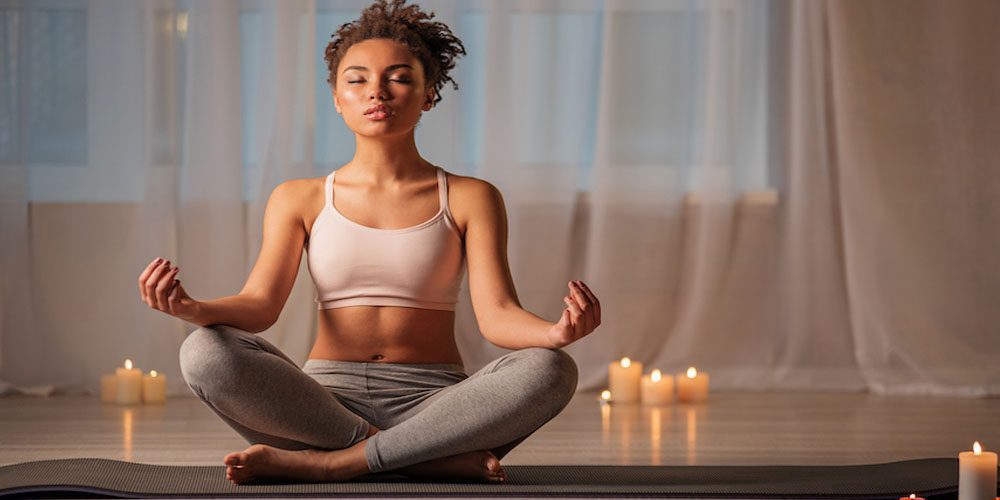Meditating is a great way to relax and reduce stress, but did you know there are several different types of meditation to choose from? Each one has its own benefits and style, so it’s important to find the right one for you. In this blog post, we’ll explore the different types of meditation and why each one can be beneficial for your wellbeing.
The different types of meditation
First, let’s look at mindfulness meditation. This type of meditation focuses on bringing awareness to your current experience without judgement or distraction. It encourages you to pay attention to the present moment such as how your body feels in that very moment and not become distracted by thoughts or feelings in the past or future. Practicing mindfulness meditation can help reduce stress, improve concentration and increase self-awareness.
Another popular type of meditation is transcendental mediation (TM). TM is a mantra-based practice that involves chanting a mantra silently or aloud while simultaneously relaxing different areas of your body. The focus of TM is not necessarily spiritual but instead seeks to reach a state of deep relaxation within the body through repetition of the Mantra. People who practice TM often report feeling more energized afterwards due to its ability to create an inner sense of harmony and balance.
Additionally, guided meditation is another type of mindful practice that often incorporates elements from both mindfulness and TM practices though with some subtle differences. Guided meditations involve using an audio guide with spoken instructions on how to relax each part of your body until reaching a place of deep relaxation. People have found success with this type of meditation especially if they struggle with staying focused during traditional solo practices like mindfulness or TM meditations as the audio guide helps keep them grounded in the present moment during their session.
The Benefits of Meditation
Meditating has numerous benefits, both mentally and physically. For example, studies have been conducted to suggest that mindfulness meditation can reduce stress, improve concentration and even help people cope with chronic pain. It’s also associated with improved sleep patterns which helps individuals stay alert during the day while being able to take on more tasks and attain goals in a more efficient manner. Additionally, meditating can lead to improved moods as the practice helps create an inner sense of peace and equanimity. People often report feeling calmer after their meditation session due to the fact that it helps them refocus their energy on controlling their breath rather than worrying about things outside of their control.
Apart from physical health benefits, meditating has many cognitive improvements too as research suggests it can heighten creativity, increase productivity and boost problem solving skills. This is because when meditating your mind is able to sink into deep focused states allowing new thought patterns to emerge organically which leads to innovative ideas or solutions for issues you may be facing in life.
Overall, there are countless benefits of meditating no matter what type you choose so why not give it a try? Whether you’re looking for an effective way to manage stress or just want some time away from technology or work then make sure you incorporate meditation into your routine today.
The Power of Meditation for Mental Health
As previously mentioned, meditation has many physical benefits but it can also be beneficial to one’s mental health by helping individuals move past traumas, fears or anxieties. It can act as a form of therapy or catharsis which allows people to externalize any emotions they may be dealing with in order to let them go and release the pent-up energy.
Additionally, meditating can provide an inner sense of stability and security while also creating a space for self-exploration and discovery. This is because meditation encourages one to look within rather than outwardly distract themselves with outside activities or events which makes it easier to get in touch with any feelings brewing inside so they can be acknowledged and accepted rather than ignored or suppressed.
Studies have also been conducted to suggest that consistent meditation practice helps reduce symptoms of depression, anxiety and insomnia by calming the nervous system and providing relaxation from all levels – physical, emotional and mental. Furthermore, it can help improve self-esteem as most meditation practices involve some form of self-compassion which has been linked to improved confidence levels over time after sustained practice.
All in all, meditating is a powerful tool for overall wellbeing and should be taken advantage of regularly regardless if you’re struggling with a particular mental health issue or just looking for ways to better manage stress on a daily basis. So why not give it a try today? Choose whatever type of mediation resonates with you most whether its mindfulness, TM, guided or breath work there’s sure to be something out there that fits your needs perfectly.
Different Meditation Techniques for Beginners
When it comes to meditating, it can be difficult to know where to start. There are so many different types of meditation out there that it can be overwhelming trying to figure out which one is best suited for you. However, the great thing about meditation is that there’s no right or wrong way – as long as you’re comfortable and relaxed in your practice then that’s all that matters. With that said, here are some different meditation techniques for beginners looking to get started:
Guided Meditation: This type of meditation involves listening to an audio recording or podcast with a speaker guiding you through the practice. It can be helpful for those who need some external guidance and reassurance when it comes to meditating since all you have to do is listen and follow along.
Mindfulness Meditation: Mindfulness meditation focuses on being in the present moment without any judgement or analysis of thoughts, feelings or experiences. This means simply taking notice of what’s happening around us while not attaching any extra meaning or stories to them. It helps us become more aware of our environment and how we interact with it instead of being stuck in our own heads all the time.
Transcendental Meditation (TM): TM has been popularized by celebrities over the years but essentially this type of meditation is based on using a mantra-based repetition technique in order to quieten the mind and body allowing for relaxation and peace from chronic stress levels. It allows users to empty their minds from thoughts and focus on their breathing instead which can help bring clarity and mental clarity into one’s life.
Breath Work Meditation: This practice uses breath as a tool for achieving a deeper awareness of self while also focusing on relaxing the body physically and mentally. The aim is also to use certain breathing techniques such as “square breathing” (breathing in through your nose while counting 1-4; hold your breath counting 1-4; exhale through your mouth counting 1-4 & repeat) in order gain control over both physical sensations like heartrate and emotional state such as anxiety levels.
No matter what type of meditation you decide to go with, it’s important not to give up if things don’t seem perfect at first – Rome wasn’t built overnight! With consistent practice, anyone can learn how to meditate properly and reap its various benefits from better sleep quality, improved mood stability, enhanced memory function etc… So why not start today?
How to Meditate: A Tutorial for Beginners
Learning how to meditate may seem daunting at first, but it’s actually quite straightforward. All you need is a quiet and comfortable space, your favorite relaxing music (optional), and a few minutes of uninterrupted time. Here’s a step-by-step guide on how to meditate properly:
Step 1: Find a Comfortable Position – Sit in whatever position feels best for you. If you’re sitting in a chair, make sure to keep your back straight with your feet flat on the ground. If you’re sitting cross-legged, try to maintain good posture by keeping your spine straight and shoulders relaxed.
Step 2: Close Your Eyes – As clichéd as this may sound, it really helps to close your eyes when doing meditation because it helps you avoid visual distractions and sharpens focus. You could also opt for an eye pillow or face mask for extra comfort and relaxation.
Step 3: Start Breathing – Slow down your breathing by focusing on each inhale and exhale (this will help if you’re feeling overwhelmed). Make sure that each breath is deep from the diaphragm so that oxygen can reach every cell of your body more easily.
Step 4: Set an Intention – Before beginning the process of meditation, set a positive intention such as “I am open to all possibilities” or “I surrender my worries” which will help affirm what you want out of the practice beforehand.
Step 5: Observe Your Thoughts – For beginners, this step can be very challenging especially if intrusive thoughts come up during meditation but remember not to judge yourself harshly or become too attached to them. Try instead to observe them without adding any extra meaning or stories then let them pass without judgment like clouds in the sky.
Step 6: Remain In The Moment – This step is all about allowing yourself to just “be” and remain present in the moment no matter what happens during meditation.
It takes practice but eventually with patience and consistency anyone can learn how to master mindfulness teaching themselves how to stay calm under pressure no matter what life throws their way.
How to Use Meditation for Physical Health and Self-Healing
The physical benefits of meditation are well-known, from reducing stress and managing chronic pain to improving sleep quality and cognitive function. However, it can also be used as an effective tool for self-healing in various ways. Here’s how to use meditation to help your body and mind:
Visualization – This technique involves using mental images for healing specific areas of the body. Think about the areas where you feel tension or discomfort and imagine yourself “inhaling” bright white light filled with positive energy into that area. Picture this light healing any negative emotions or blocks in that area then exhale out any dark sensations or thoughts.
Mindfulness – Mindfully observing your body is a great way to become aware of its physical needs. Pay attention to the different parts of your body while breathing deeply, paying special attention to areas which may have been neglected before. With consistent practice, this will help you become more conscious and attuned with yourself while also helping you discover new paths towards self-care.
Affirmations – While meditating, repeating affirmations like “I am strong” or “I am loved” can help us remind ourselves of our worthiness on all levelss—mental, physical and spiritual. Speaking these words aloud (or in your head) can build up positive energy around us that encourages self-love and creates a sense of confidence even when we’re feeling down or overwhelmed by life’s challenges.
There are many different ways to approach meditation and really it depends on personal preference when it comes to deciding what works best for each individual. Regardless of what type of meditation practice you decide to go with though, remember that consistency is key as it takes time for our minds and bodies to take notice of the changes taking place within us through meditations effects so don’t give up too soon.
How to Use Meditation to Attract What You Want in Life
Have you ever wished for something that felt just out of reach? Have you ever asked yourself why your life isn’t quite what you want it to be? If so, then meditation may be the answer. It’s an incredibly powerful tool that can help us bring into our lives whatever we focus on through the power of our intention and belief. Here are some tips on how to use meditation to attract what you want in life:
Set Your Intention – Before beginning a session of meditation, take time to reflect on what it is your heart truly desires—whether it’s money, relationships, physical health or any other aspect of your life. Spend a few minutes visualizing this desire as though it has already been achieved and feel the emotions associated with having achieved it. This will help set the tone and increase your focus during mediation, helping you work towards your desired outcome.
Be mindful of Negativity – During a session, pay special attention to any feelings and thoughts of self-doubt and fear that arise. Rather than giving in to these negative forces, acknowledge them but don’t allow them to control or overwhelm you. Instead, use affirmations like “I am worthy” or “I believe I can achieve _____”to counteract their effects and remind yourself that anything is possible when we commit ourselves fully towards our goals.
Release Expectations – It’s important not to get too fixated on how exactly our wishes will manifest themselves but rather allow for them to come about in whatever way is best for us at the current moment as well as our long-term future. Letting go of expectations can also open up new possibilities because when we’re not too focused on one specific outcome we create more space for all kinds of possibilities!
Visualize the Outcome– Spend time during your meditations visualizing yourself having manifested what it is that you really desire in life whether its success, love or financial abundance etc.. Imagine every detail such as how would feel, look or even smell if this wish had come true! Allow yourself to luxuriate in these positive scenarios and really experience joy while doing so as these visualizations become extremely powerful tools with regular practice.
Allow Gratitude To Flow – Spending some time each day being grateful for all the positive aspects in life helps us attract even more good things into existence because gratitude develops within us an attitude of happiness which is contagious! Gratitude also helps us stay humble throughout life’s successes; never becoming too attached or complacent about our achievement but rather maintain a healthy level of curiosity about what else might lay ahead!
By utilizing meditation in this way we can become connected with ourselves whilst also inspiring others around us by letting go off doubts & worries through mindful practices thus creating space for limitless possibility —irrespective of how difficult things might seem.
How Meditation can Change Your Body Chemistry and Brain Waves
For thousands of years, meditation has been used to improve physical and mental health. It has been scientifically proven to reduce stress, anxiety, and depression while promoting emotional wellbeing. But how exactly does it work? The answer lies in how meditation affects the body’s chemistry and brain waves.
Meditation stimulates the release of hormones that are responsible for relaxation, such as endorphins, serotonin, melatonin and oxytocin. Endorphins are released when we experience pleasure or pain relief; serotonin is known to boost mood and reduce anxiety; melatonin helps us sleep better; and oxytocin reduces stress hormones like cortisol. These hormones create a sense of calmness and peace which can help us gain clarity on our thoughts, enabling us to think more clearly.
In addition to this, meditation also changes electrical activity in the brain. Research shows that regular practice increases alpha wave activity in the brain – alpha waves are associated with relaxed states of consciousness such as daydreaming and meditating. Alpha waves have a calming effect on the nervous system which can help counteract stress-induced states such as agitation or anxiety. Meditation also increases activity in areas of the brain associated with attention and concentration – something that many people find challenging when stressed or overwhelmed by life’s demands!
When practiced regularly over time, these changes in body chemistry and brain waves create profound effects on our overall physical, mental, emotional and spiritual health. Regular practice strengthens our capacity for self-awareness while cultivating self-compassion which can make us more capable of dealing with life’s challenges constructively instead of reacting with impulsiveness or anger. Furthermore it boosts immunity making us less susceptible to illness & disease whilst equipping us with tools to cope better during times of crisis ensuring utmost resilience no matter what life throws at us!
In conclusion: regular practice of meditation helps to create balance within—mind body & spirit– whilst providing long lasting beneficial effects that promote physical wellbeing & encourage positivity throughout every aspect off life.
Different Brain Waves and Their Effects on Mental and Physical Health
Different types of brain waves are produced by different parts of the brain and have different effects. Beta waves are the fastest type, associated with higher levels of arousal, alertness, thinking and reasoning. Alpha waves are slower than beta waves, associated with a relaxed state of inner peace and calm.
Theta waves are even slower, seen as an intermediate between conscious thinking and dreaming/deep meditation, producing a highly creative state. Lastly there is Delta waves—the slowest type—associated with deep sleep and restorative healing processes in the brain and body.
Aside from their general effects on one’s overall mental and physical health, each type of wave has its own unique impact on daily life:
Beta Waves – These fast-paced brainwaves help us remain focused on task at hand but can lead to overstimulation if too much time is spent in this state – making it important to take regular breaks or engage in activities that invite more alpha wave activity such as yoga or walking in nature.
Alpha Waves – An ideal frequency for relaxation, these waves can reduce stress levels whilst also improving concentration & focus (particularly relevant when studying or working).
Theta Waves – A great conductor for creativity due to it’s ability to induce an open & meditative state; allowing information & ideas to flow more freely whilst promoting problem solving & critical thinking skills.
Delta Waves – Being the slowest wave type it helps us attain deep sleep & keeps our body functioning optimally which is essential for our overall wellbeing. Furthermore delta waves aid in restoring physical energy & emotional balance which can be beneficial if we’re feeling exhausted or simply need some extra rest after a long day at work or school.
Ultimately although they may vary greatly in terms of frequency each one of these brainwave types plays an integral part in balancing our mental & physical health. Increasing awareness of how they affect us can allow us to make lifestyle modifications accordingly so that we’re able to reach our fullest potential throughout life.
Takeaways
We hope this article has helped you understand how meditation can change your body chemistry and brain waves. We encourage you to take some time to explore and experiment with different types of meditation to find what works best for you. Your personal experiences and opinions are valuable, so please share your thoughts in the comments section below. Thank you for taking the time to read, we appreciate it. And if you have any questions or would like to learn more, feel free to contact us.























